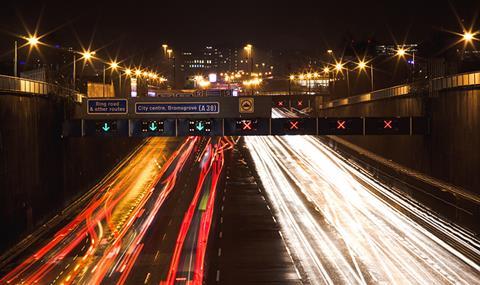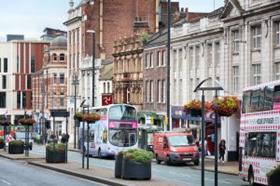
Hauliers are no doubt still catching their breath from London’s double whammy of an earlier Ultra Low Emission Zone (ULEZ) start date and the prospect of it expanding capital-wide by 2020.
But it is also essential for hauliers to follow closely the clean air zone plans (CAZ) taking shape nationwide to ensure their fleets are Euro-6 ready when these start to roll out from 2019.
Alongside London, the first five major cities mandated by the government to have a CAZ in place by 2020 were Birmingham, Leeds, Nottingham, Derby and Southampton – so MT has taken a look at where these are at to date.
Leeds
Leeds City Council last week published its CAZ consultation plans, which, if approved by its executive board, will go out to public consultation in January 2018.
It reveals plans for a category B zone in the city centre, which will require HGVs to meet Euro-6 emissions standard.
The scope of the Leeds CAZ includes HGVs, buses, coaches, private hire and taxis, however does no affect vans and cars.
It will apply to all roads within the Leeds outer ring road, with the motorways acting as the southern boundary.
Leeds has proposed a charging regime that follows that of the London ULEZ, which sees £100 for lorries not meeting Euro-6 emissions standard.
The council said it will explore a number of areas within its consultation, such as business support packages to provide financial assistance to switch to cleaner fuels, and ways to raise awareness of air quality issues.
It also plans to consider the possibility of exemptions being awarded for specific classes of vehicle, or ‘sunset’ periods to provide additional time for certain vehicle users to upgrade. However, it said a robust case would need to be made in these cases.
Councillor Lucinda Yeadon, Leeds City Council executive board member with responsibility for sustainability and the environment, said: “In Leeds ensuring that we improve air quality and therefore the lives of all the people living and working in the city is a real priority for us.”

The consultation period, which will run throughout January 2018, is to be used to further assess the barriers faced by drivers whose vehicles currently fail to meet compliance standards.
Following this, a final report will be submitted to the government towards the end of summer 2018 for them to sign off on the final proposal for Leeds.
Leeds said it has already implemented a number of initiatives to boost air quality in the city, including trials of new technology and the development of a new transport strategy.
These include switching its own fleet to ultra-low or zero-emission vehicles: currently the council has more than other local authority in England.
It is developing compressed natural gas (CNG) infrastructure for the city to enable its own fleet of vehicles, including its RCVs, to switch to natural gas as well as enabling commercial fleet operators to benefit from using the site.
Leeds is also carrying out a geofencing trial as part of project ACCRA. This will test smart-city technology applications that demonstrate real-time emissions control, using live air-quality data to trigger electric hybrid engines to automatically switch to zero-emission mode in heavily polluted areas.
In addition, it has secured £150,000 in partnership with clean cool technology firm Dearman to investigate the potential to reduce the impact of refrigerated transport on air quality in Leeds.
Southampton
Southampton council says that road transport is the biggest contributor to poor air quality in the city, with HGVs accounting for 34%, vans comprising 7.5%, buses 4.5% and cars around 24%.
Like Leeds, it plans a series of measures to address poor air quality, which have already commenced this year and include plans to:
- Establish a freight quality partnership;
- Work with businesses to promote better consolidation of goods and last-mile deliveries in ultra-low-emission vehicles;
- Provide guidance for new construction developments to consider sustainable transport requirements and use cleaner plant during building work.
It will also be introducing a penalty charging regime in its most polluted areas, which will come into effect by the end of 2019. Technical assessments are still being carried out as to the geographical reach of this zone, with the proposal expected to be published early next year.

Speaking earlier this year to MT sister title Freight in the City at a Making Consolidation Centres Work event, Neil Tuck, programme manager for the local sustainable transport fund at Southampton, said that he expected HGVs may face charges of between £100 and £200 if not reaching Euro-6 standards.
Tuck said Southampton was currently home to a quarter of a million people and a major transport hub, including the biggest cruise port and second largest container hub in the UK.
Population growth during the next few years is expected to add 20% to current traffic levels alone.
“We are one of the worst cities in the UK in regards breaching air pollution safety guidelines,” he said.
Southampton operates a successful Sustainable Distribution Centre, operated by Meahcres Global Logistics, to reduce freight journeys through greater consolidation of goods.
“While many HGVs are not at CAZ level, the idea is that the Sustainable Distribution Centre will be outside the boundary,” Tuck added.
Birmingham
In response to the government’s mandate for it to introduce a CAZ, Birmingham City Council (BCC) is currently undertaking a feasibility study to help it understand the best ways to implement this and other measures to put in place.
This included a survey on the way deliveries and collections of goods are carried out to the city’s businesses.
The council is yet to decide the scope of any CAZ in Birmingham, with further details expected to be published next year.

However, in a letter sent in response to the consultation on Defra’s Air Quality Plan, Stella Manzie, interim chief executive of BCC provided some insight into the scale of vehicles affected.
The letter said in response to the topic of retrofitting that: “Data from recent Automatic Number Plate Recognition surveys suggests that the proportion of CAZ compliant diesel LGV and HGV vehicles currently entering the city centre is around 3% and 14% respectively.”
It also reveals that out of 400 refuse lorries operated in Birmingham (both private and public sector), that only 10% of this fleet is compliant.
“Euro-6 vehicles are available,” said the letter. “However, the cost is prohibitive and no financially viable second-hand market exists. There are also around 200 tipper trucks and cage trucks none of which are compliance.”
Derby
Derby has yet to submit its full CAZ proposals to the government; however its preferred model stated in March this year was to implement a category B zone that would include HGVs.
This would be introduced to roads inside the inner road by 2020, and expanded to its outer ring road by 2025.
More details expected to be published next year.
Derby has been working on a number of complementary air quality initiatives in collaboration with the Joint Air Quality Unit to help raise awareness of the issue and engage with businesses and residents.
This includes securing a £250,000 air quality grant to retrofit the council’s HGV fleet with emissions-reduction technology.
Nottingham
Nottingham has also yet to release firm details of its CAZ.
It is classed as one of the government’s Go Ultra Low Cities, which means it will act as a trailblazer for leading the adoption of electric vehicles and charging infrastructure.
Nottingham runs one of Europe’s largest fleets of electric buses, as well as the world’s largest fleet of biomethane-powered buses.














